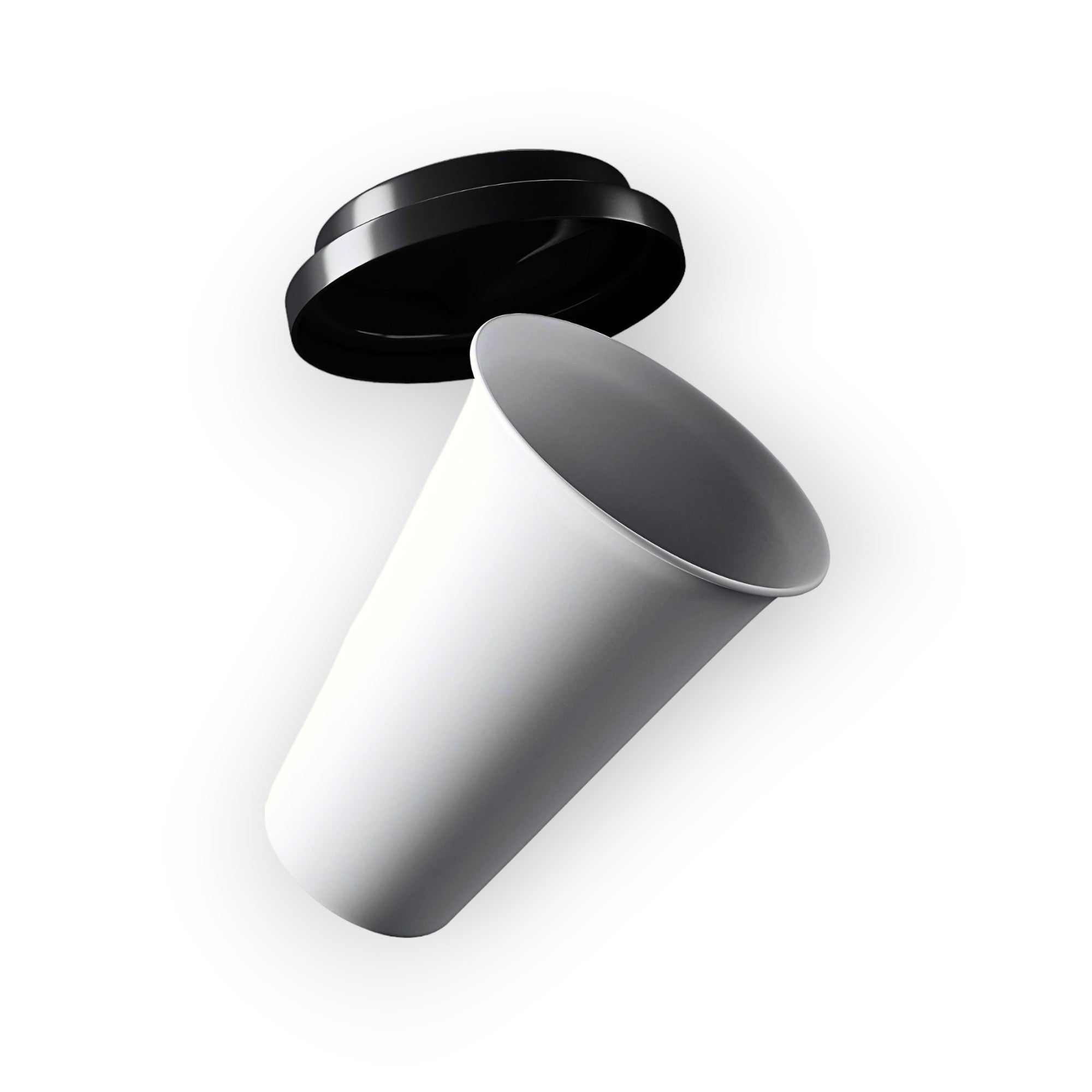A Guide to Choosing the Perfect Coffee Cup Size for Your Business
In the dynamic world of coffee service, selecting the right cup size is a critical decision that can significantly impact your business's success. It's not just about volume. The perfect cup size enhances customer satisfaction, optimizes operational efficiency, and even influences brand perception. This comprehensive guide will navigate you through the intricate process of choosing ideal coffee cup sizes for various business settings, from bustling cafes to corporate offices and special events.
The Science of Cup Sizing
At its core, cup sizing is a blend of art and science. It's about precision. But it's also about perception.
Volume and Thermal Dynamics
The volume of a coffee cup directly affects the drink's temperature retention. Larger cups have a greater surface area, leading to faster heat dissipation. This phenomenon is governed by Newton's Law of Cooling:

Where:
- T is the temperature of the coffee
- Ta is the ambient temperature
- k is the cooling constant
- t is time
Smaller cups, with their reduced surface area, maintain temperature more effectively. This is crucial for espresso-based drinks where temperature significantly impacts flavor profiles.
Psychological Aspects of Cup Size
Cup size influences perceived value and satisfaction. A study in the Journal of Sensory Studies found that participants reported higher satisfaction levels when consuming coffee from larger cups, even when the volume remained constant. This psychological effect, known as the "size-contrast illusion," can be leveraged to enhance customer experience.
Standard Coffee Cup Sizes and Their Applications
Understanding standard sizes is fundamental. Let's break it down:
- 4 oz (118 ml): Ideal for espresso and macchiato. Short and stout.
- 6 oz (177 ml): Perfect for cappuccinos. Balances espresso and milk harmoniously.
- 8 oz (237 ml): The classic. Suitable for lattes, flat whites, and standard drip coffee.
- 12 oz (355 ml): Popular for larger lattes and cold brews. Offers more volume without overwhelming.
- 16 oz (473 ml): The "grande" size. Excellent for iced drinks and specialty beverages.
- 20 oz (591 ml): For those who need a substantial caffeine hit. Often used for cold drinks and smoothies.
Each size serves a specific purpose. Choose wisely.
Tailoring Cup Sizes to Business Types
Different businesses have unique needs. One size doesn't fit all.
Cafes and Coffee Shops
In this setting, variety is key. Offer a range of sizes to cater to diverse preferences. Consider:
- Espresso shots in 4 oz cups
- Cappuccinos in 8 oz cups
- Standard drip coffee in 8 oz and 12 oz options
- Specialty drinks in 16 oz cups
Implement a tiered pricing strategy based on size. This encourages upselling while providing options for budget-conscious customers.
Corporate Offices
Office environments require a different approach. Focus on practicality and efficiency:
- 8 oz cups for standard coffee servings
- 12 oz options for those needing a bigger boost
- Consider reusable mugs to promote sustainability
In offices, consistency is crucial. Standardize sizes to simplify ordering and inventory management.
Events and Catering
Flexibility is paramount in event settings.
Consider:
- 6 oz cups for formal events where multiple beverages are served
- 8 oz and 12 oz options for casual gatherings
- Disposable cups for large events to facilitate easy cleanup
Adapt your selection based on the event type, duration, and client preferences.
Factors Influencing Cup Size Selection
Several factors come into play when choosing the right cup sizes:
- Customer Demographics
Understand your target audience. Younger consumers often prefer larger sizes, while older demographics may opt for smaller, more traditional servings.
- Local Culture and Preferences
Coffee culture varies globally. In Italy, a 4 oz cappuccino is standard. In America, 16 oz lattes are commonplace. Align your sizes with local expectations.
- Operational Considerations
Consider your equipment capabilities. Ensure your espresso machine's group heads accommodate your chosen cup sizes. Factor in storage space and dishwashing capacity for reusable cups.
- Cost and Profit Margins
Larger cups require more ingredients, impacting costs. However, they also allow for higher price points. Strike a balance between profitability and value perception.
- Environmental Impact
Sustainability is increasingly important. Smaller cups reduce waste. Consider offering discounts for customers who bring reusable cups.
The Role of Cup Design in Size Selection
Cup design significantly influences the perceived size and overall drinking experience. Key design elements include:
Shape and Proportions
The cup's shape affects both aesthetics and functionality. Tulip-shaped cups enhance the aroma of espresso-based drinks, while straight-sided cups are better for latte art. The height-to-width ratio impacts perceived volume and heat retention.
Material Considerations
Different materials offer varying benefits:
- Ceramic: Excellent heat retention, ideal for sit-down service
- Glass: Visually appealing, perfect for layered drinks
- Paper: Convenient for takeaway, and a more hygienic option
- Double-walled: Provides superior insulation for both hot and cold beverages
Choose materials that align with your business model and customer expectations.
Customization and Branding Opportunities
Cup size selection offers unique branding opportunities. Consider:
- Custom sizes that set you apart from competitors
- Branded cups that serve as mobile advertisements
- Size-specific designs that enhance the overall aesthetic
Innovative approaches, like color-changing cups or interactive QR codes, can turn your cups into conversation starters.
Implementing a Multi-Size Strategy
A well-planned multi-size strategy can optimize your coffee service:
- Core Sizes: Identify 2-3 core sizes that meet most of your customers' needs.
- Specialty Sizes: Offer unique sizes for signature drinks or limited-time offerings.
- Flexible Options: Allow for customization, such as extra shots in smaller cups.
Regularly analyze sales data to refine your size offerings. Be prepared to adapt to changing trends and customer preferences.
Future Trends in Coffee Cup Sizing
The coffee industry is ever-evolving. Emerging trends include:
- Smart cups with temperature control features
- Biodegradable materials for eco-conscious consumers
- Augmented reality experiences integrated into cup designs
Stay informed about these innovations to keep your business at the forefront of the industry.
Selecting the perfect coffee cup size is a nuanced decision that impacts various aspects of your business. It requires a deep understanding of your customer base, operational capabilities, and brand identity. By carefully considering the factors outlined in this guide, you can develop a cup sizing strategy that enhances customer satisfaction, optimizes operations, and sets your business apart from your competition.
Remember, the perfect cup size is not just about containing liquid; it's about crafting an experience. It's about precision in service and perception in value. As you implement your cup sizing strategy, continually seek feedback and be willing to adapt. The coffee industry is dynamic, and so should be your approach to serving it. In the end, the perfect coffee cup size is one that delights your customers, aligns with your brand, and contributes to your business's success. Choose wisely, and watch your business grow, one perfectly sized cup at a time.
References
- Van Ittersum, K., & Wansink, B. (2012). Plate size and color suggestibility: The Delboeuf Illusion's bias on serving and eating behavior. Journal of Consumer Research, 39(2), 215-228.
- Spence, C., & Van Doorn, G. (2017). Does the shape of the drinking receptacle influence taste/flavour perception? A review. Beverages, 3(3), 33.
- Guéguen, N. (2003). The effect of glass colour on the evaluation of a beverage's thirst-quenching quality. Current Psychology Letters, 11(2).
- Piqueras-Fiszman, B., & Spence, C. (2012). The influence of the color of the cup on consumers' perception of a hot beverage. Journal of Sensory Studies, 27(5), 324-331.
- Harrar, V., & Spence, C. (2013). The taste of cutlery: how the taste of food is affected by the weight, size, shape, and colour of the cutlery used to eat it. Flavour, 2(1), 21.


